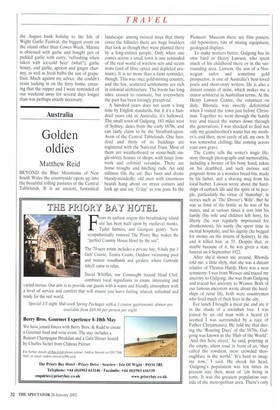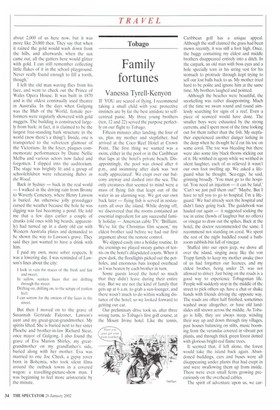Australia
Golden oldies
Matthew Reid
BEYOND the Blue Mountains of New South Wales the countryside opens up into the beautiful rolling pastures of the Central Tablelands. It is an ancient, fantastical landscape: among twisted trees that thinly cover the hillsides there are huge boulders that look as though they were planted there by a long-extinct people. Only when one comes across a small town is one reminded of the real world of wireless sets and steam irons (and of fibre optics and depleted uranium). It is no more than a faint reminder, though. This was once gold-mining country, and the few, scattered settlements are rich in colonial architecture. The boom has long since ceased to resonate, but everywhere the past has been lovingly preserved.
A hundred years does not seem a long time by English standards, but if it's a hundred years old in Australia, it's hallowed. The small town of Gulgong, 183 miles west of Sydney, dates from the early 1870s, and can fairly claim to be the Stratford-uponAvon of the Central Tablelands. One hundred and thirty of its buildings are registered with the National Trust. Most of them are weatherboard or stone-built single-storey houses or shops, with fancy ironwork and colonial verandas. There are horse troughs and hitching rails. An odd stillness fills the air; flies buzz and drone bloody-mindedly; old men with enormous beards hang about on street corners and look up and say `G'day' as you pass. In the Pioneers' Museum there are film posters, old typewriters, bits of mining equipment, geological displays.
To make matters better, Gulgong has its own bard in Henry Lawson, who spent much of his childhood there or in the surrounding area. Lawson, the son of a Norwegian sailor and sometime gold prospector, is one of Australia's best-loved poets and short-story writers. He is also a distant cousin of mine, which makes me a minor aristocrat in Australian terms. At the Henry Lawson Centre, the volunteer on duty, Rhonda, was sweetly deferential when I visited the town just before Christmas. Together we went through the family tree and traced the names down through the generations. I was shocked to find not only my grandmother's name but my mother's, and then, most eerily of all, my own. It was somewhat chilling; like coming across your own grave.
The Centre tells the writer's tragic lifestory through photographs and memorabilia, including a bronze of his bony hand, taken on his deathbed, and such curious and poignant items as a wooden bread-bin, made by his father, and a shaving mug from his local barber. Lawson wrote about the hardships of outback life and the spirit of its people, particularly the virtue of `mateship', in stories such as 'The Drover's Wife'. But he was as fond of the bottle as he was of his mates, and at various times it cost him his family (his wife and children left him), his liberty (he was regularly imprisoned for drunkenness), his sanity (he spent time in mental hospitals), and his dignity (he begged for money on the streets of Sydney). In the end it killed him, at 55. Despite that, or maybe because of it, he was given a state funeral on 4 September 1922.
After she'd shown me around, Rhonda told me, a little shyly, that she was a distant relative of Thomas Hardy. Here was a neat symmetry: I was from Wessex and traced my ancestry to Gulgong; she was from Gulgong and traced her ancestry to Wessex. Both of our famous ancestors wrote about the hardships of rural life, both were countrymen who lived much of their lives in the city.
For lunch I bought a meat pie and ate it in the shade of a coolabah tree. I was joined by an old man with a beard (it seemed I was surrounded by a race of Father Christmases). He told me that during the 'Roaring Days' of the 1870s, Gulgong was known as the 'Hub of the World'. 'And this here street,' he said, pointing at the empty, silent road in front of us, `they called the rowdiest, most crowded thoroughfare in the world.' It's hard to imagine now,' I said. He shook his head. `Gulgong's population was ten times its present size then, most of 'em living in tents. It was the greatest population outside of the metropolitan area. There's only about 2,000 of us here now, but it was more like 20,000 then. They say that when it rained the gold would wash down from the hills, and afterwards, when the sun came out, all the gutters here would glitter with gold. I can still remember collecting little flakes of it in the school playground. Never really found enough to fill a tooth, though.'
I left the old man waving flies from his face, and went to check out the Prince of Wales Opera House. It was built in 1870 and is the oldest continually used theatre in Australia. In the days when Gulgong was the Hub of the World, female performers were regularly showered with gold nuggets. The building is constructed largely from bark; in fact, it is claimed to be the largest free-standing bark structure in the world (now there's a thing!). Inside, one is transported to the velveteen glamour of the Victorians. In the foyer, plaques commemorate performances by Dame Nellie Melba and various actors now faded and forgotten. I slipped into the auditorium. The stage was brightly lit and a group of schoolchildren were rehearsing Babes in the Wood.
Back in Sydney — back in the real world — I walked in the driving rain from Bronte to Waverly Cemetery, where Henry Lawson is buried. An otherwise jolly gravedigger cursed the weather because the hole he was digging was fast becoming a pond. He told me that a few days earlier a couple of drunks (old ones with big beards, apparently) had turned up in a dusty old car with Western Australia plates and demanded to be shown the way to Lawson's grave. They said they just wanted to have a drink with him.
I paid my own, more sober respects. It was a lowering day. I was reminded of Lawson's lines about the city:
1 look in vain for traces of the fresh and fair and sweet,
In sallow, sunken faces that are drifting through the street.
Drifting on, drifting on, to the scrape of restless feet: I can sorrow for the owners of the faces in the street.
But then I moved on to the grave of Susannah Gertrude Falconer, Lawson's aunt and my great-great-grandmother. My spirits lifted. She is buried next to her sister Phoebe and brother-in-law Richard Stear, once mayor of Gulgong. I also found the grave of Eva Marion Shirley. my greatgrandmother on my grandfather's side, buried along with her mother. Eva was married to one Joe Check, a gypsy rover born in Bohemia, who took silent films around the outback towns in a covered wagon: a travelling-picture-show man. I was beginning to feel more aristocratic by the minute.



















































































 Previous page
Previous page